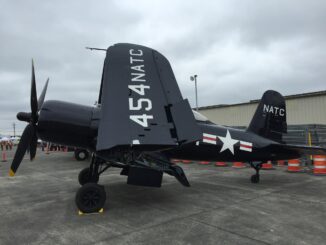
On October 2nd, 1946, the Vought F6U Pirate took to the skies, marking one of the earliest U.S. attempts to shift to jet-powered fighters from conventional piston engines. The Pirates’s development in the mid-1940s represented a significant step in military aviation post World War II. The transition became essential because of the growing need for jet aircraft that could operate from aircraft carriers and give an advantage to the U.S. Navy. Thus, the addition of a jet aircraft would provide the military with superior speed and combat capability. Considering the ongoing demand for jet-powered fighters, the Navy’s Bureau of Aeronautics (BuAer) issued a specification for a single-seat, carrier-based fighter on September 5th, 1944. The specification also included that a Westinghouse 24C axial turbojet must power the aircraft. In response, Vought, an established manufacturer with a record of producing successful naval aircraft, submitted its design for the F6U Pirate. The design was a success, and Vought won the contract for three V-340 prototypes on December 29th, 1944. Thus leading to the development of F6U Pirate.

The Prototypes
The F6U Pirate was intended with a primary role in air superiority as a lightweight, jet-powered fighter that would operate from aircraft carriers. Hence offering speed and performance advantages over its predecessors. The design that won the contract included straight wings, a characteristic of early jet aircraft, and it was constructed using new materials. These fairly new materials included metal bonding techniques like aluminum alloy that improved structural integrity while reducing weight. With the successful manufacturing of the prototypes, the F6U pirate took its first flight on October 2nd, 1946, from the Vought testing facility in Connecticut. The plane was flown by Boone Gyton, a Vought test pilot. The flight’s primary objective was to evaluate the aircraft’s handling and performance at low altitudes, and it revealed some limitations and challenges.

Operational Pirate
A year later, after the Pirate’s first flight, in 1947, 30 production aircraft orders were placed. The production aircraft’ comprised an ejection seat, a reformed vertical stabilizer, and two auxiliary fins. These fins were installed on the tip of each side of the tailplane in an attempt to improve the directional stability of the aircraft. Additionally, the fuselage was also lengthened to fit additional equipment along with the wing fillets added at the rear junction with the fuselage. However, even after undergoing several modifications, Pirate had a short operational career. The 30 aircraft that were ordered collected a mere 945 hours of flight time in total. Some planes recorded as little as six hours in the air, and thus, the aircraft was mainly operated for the development of arresting gear and barriers by the end of its operational career.

The Innovative Attempts
The F6U comprised several unique and advanced features of its time, especially being one of the first U.S. jets to use metal bonding techniques in its construction. This new design gave the aircraft a lighter and more durable airframe. It housed a Westinghouse J34-WE-30 turbojet engine with 3,000 lbf thrust, which later proved to be insufficient for a jet fighter. The engine provided a maximum speed of 599 mph with a range of only 1,100 miles, which wasn’t enough in the long run for a jet-powered aircraft. However, while overcoming this problem, Pirate became one of the first jet fighters to utilise afterburners. This technology burned extra fuel in order to increase engine thrust. Despite the alterations made to enhance the aircraft, it underperformed with its insufficient thrust. Other than the issues in engine performance, the F6U Pirate faced stiff competition from other designs as well. Since it was only one of many aircraft developed during the U.S. Navy’s experimentation with early jet technology.

The Grounded Pirate
After a long duration of several attempts at testing and reforming, the F6U Pirate’s performance fell short of expectations. Apart from the insufficient thrust from the engine, the aircraft suffered from significant structural and aerodynamic issues. These issues were fatal and included instability during high-speed manoeuvres and problems with the engine’s afterburner. Moreover, The F6U Pirate faced competition and was quickly overshadowed by more advanced jet designs like the Grumman F9F Panther and McDonnell F2H Banshee. These jets had superior performance and were more reliable. The Navy ultimately decided that the F6U Pirate was not suitable for combat operations, and the program was canceled.

Present Day
Today, none of the original F6U Pirates are in active service. However, one example of the F6U Pirate can be found at the National Naval Aviation Museum. It stands as a reminder of the early days of jet-powered flight and the challenges of transitioning from piston-engine fighters to jets. It remains an experimental aircraft that inspired the way for more successful naval jets by providing valuable instructions for designers in development and testing.

Related Articles
"Haritima Maurya, pen name, ""Another Stardust,"" has been passionate about writing since her school days and later began sharing her work online in 2019. She was drawn to writing because of her love for reading, being starstruck by the art of expression and how someone can make you see and feel things exclusive to their experience. She wanted to be able to do that herself and share her mind with world cause she believes while we co exist in this beautiful world least we can do is share our little worlds within.
As a commercial pilot, Haritima balances her passion for aviation with her love for storytelling. She believes that, much like flying, writing offers a perspective beyond the ordinary, offering a bridge between individual experiences and collective understanding.
Through her work, ""Another Stardust"" aims to capture the nuances of life, giving voice to moments that resonate universally. "








Be the first to comment
Graphic Design, Branding and Aviation Art